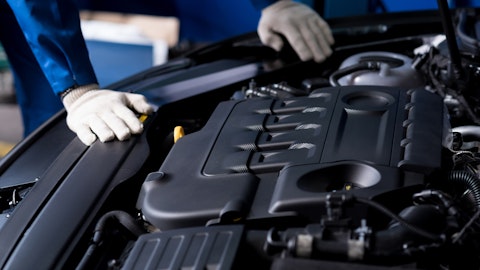Joe Massaro : Yes. Let me start with that and then I go to H1, H2 Itay. I would say that, that is — we’ve talked about that, not necessarily in the context of the restructured dollars, but things like pivoting engineering to best-cost countries those types of activities, it’s obviously what you’re seeing. And as we laid out at Investor Day, particularly with engineering, that’s really the established margin guidance into 2025, right? So, I would think of that as us taking the necessary actions over time to continue to move toward that commitment versus something incremental. From a bridge perspective, from an H1 to H2, I’m not going to give a lot of detail, but you’re going to see a couple of things. There’s a slight volume uptick, a little less than $100 million.
That sort of flows at call it, 30% on volume. FX will be better. We had about — be better by about $30 million. We don’t expect that these current rates to have as much transaction hits as we did in the first half as we adjusted down. And then you’ve got, what I’ll call, performance initiatives as well as some inflation recovery, that’s going to be over $100 million. That’s really the big bucket. Some of that’s coming out of disruption costs. The other, as I noted, is going to be a continued march on these performance initiatives that we’ve talked about, and they’ll continue to improve over the back half of the year.
Itay Michaeli : Perfect. I appreciate all that detail. Thank you.
Operator: We will now move to Rod Lache from Wolfe Research. Please go ahead.
Rod Lache: Good morning, everybody. Had to just ask you kind of a couple of big picture things. One is in the margin bridge that you presented from 2022 to 2025 at your Investor Day, you had a bucket of $1.7 billion. It was — I think you called it performance. It was elimination of COVID costs, part of it was some supplier costs. Can you just update us on where that bucket stands now? And what proportion of that $1.7 billion you think we will actually see in 2023?
Joe Massaro : Yes, Rod, it’s Joe. Let me start. So, remember that Bucket big — that was a ’22 to ’25 bridge, right? So, you had — the biggest individual item in that $1.7 billion is about over $300 million, call it, $330 million to $350 million of supply chain disruption costs. We expected a lot of that to come out this year. We had $130 million in the original guide. It’s improved now, maybe around $160 million coming out this year. The balance will come out next year. The remaining is just sort of what I’ll call sort of those annual material and manufacturing improvements for the three years, ’23, ’24, ’25. I would say you could sort of take those across each of the years. They’re a little back-end loaded. They grow into ’24 and ’25.
But for the most part, we’re on track. It’s really what you’re seeing sort of come through in the performance bridges as we’ve talked, just even over the past — this past quarter, right, $70 million improvement in supply chain disruption costs alone. So, I might say we’re tracking in line with those expectations.
Rod Lache: Thanks, for that. Okay. And just switching gears. A few western companies seem to have lately realized that the EV forms that they were working on were just too expensive and we’ve already seen Volkswagen reach out to Xiaoping to use their platform and seemingly, there’s a few other discussions in the industry about using Chinese platforms. So, I’m just wondering from Aptiv’s perspective, how you — how that affects you. You did mention again on the call that you’ve been working with Volkswagen on the architecture of the future. So, would you be agnostic to that? Or is there some — are there some implications for you if that is something that continues?
Kevin Clark: Yes, Rod, maybe I’ll start with it. Listen, I think as we’ve talked about in the past, our overall outlook for penetration of battery electric vehicles and electrification overall has been — I’d say, a bit on the conservative side relative to kind of industry perspective. So that has been our underlying perspective and a significant amount of that perspective is shaped on costs and an understanding of our OEM customers and sensitivity to cost and sensitivity to the cost of new technologies. So that’s one. Two, just given the breadth of our product portfolio, given our full system approach to high-voltage electrification in this particular case, we have an opportunity to present our customers with a solution that is much lower cost than a traditional approach to battery electric vehicle architecture.




